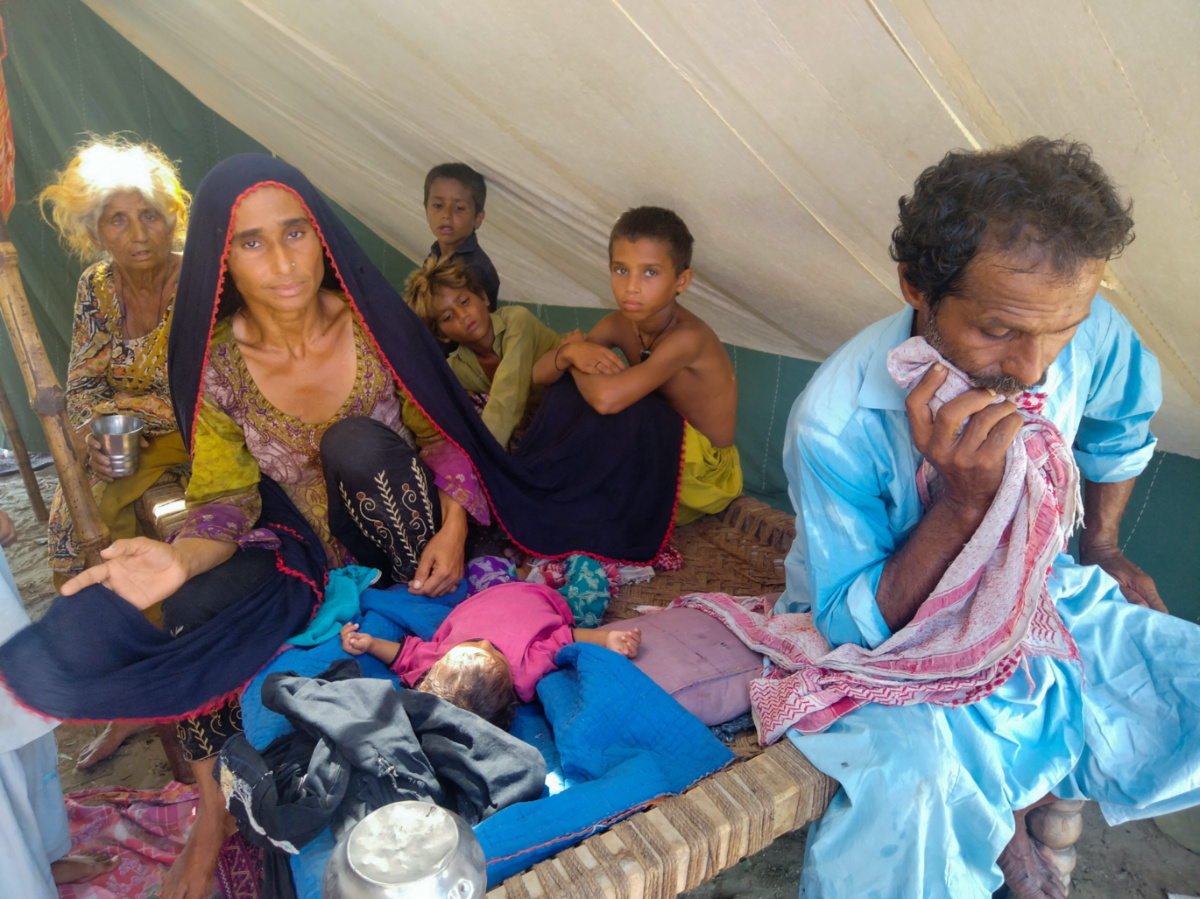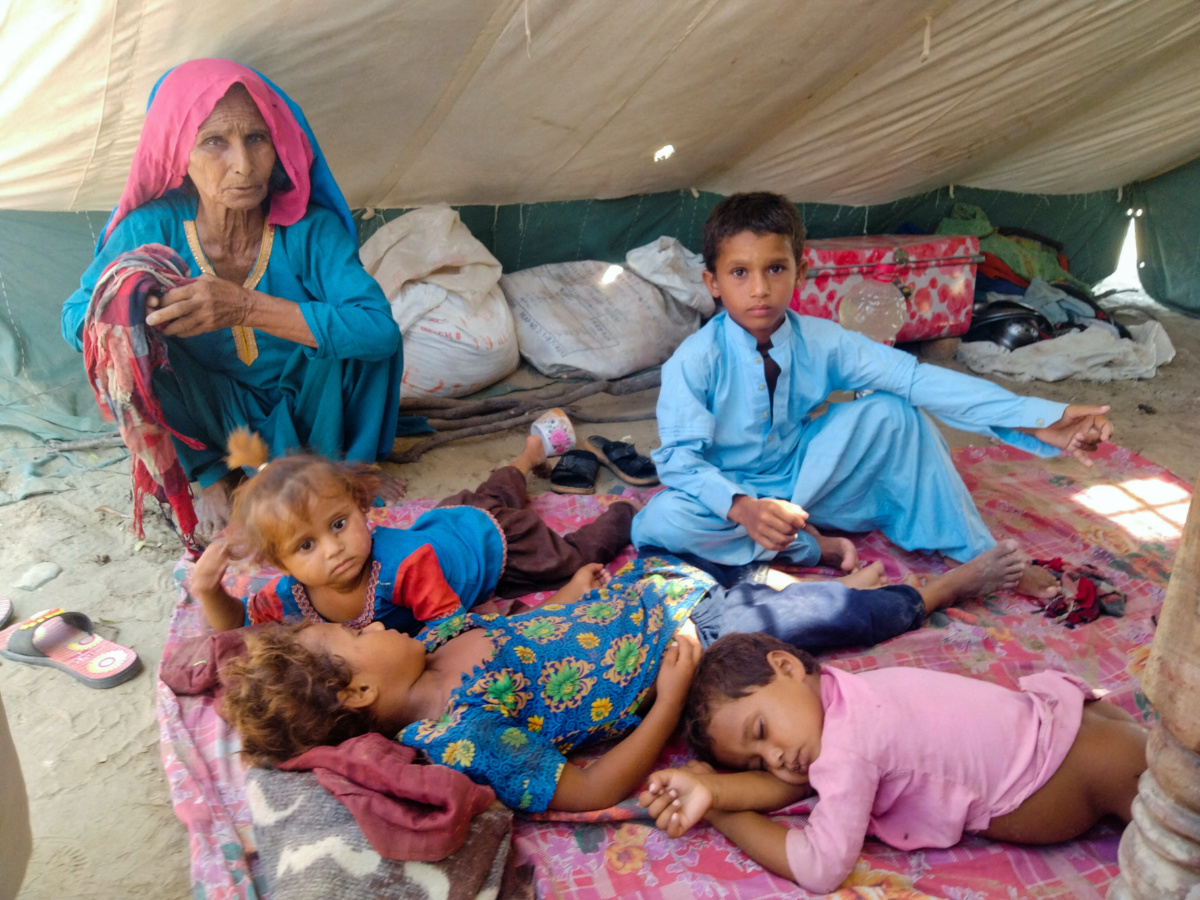Sehwan, Pakistan
Reuters
In the hours before her six-year-old son died in her lap, Badar Bibi recalled how she rushed from a field clinic set up to treat people caught in Pakistan’s worst floods in decades to a city hospital, desperate to bring down the boy’s fever.
First she took Abdul Qadeer to a makeshift medical centre set up by the air force, where doctors managed to bring down his temperature from 106 Fahrenheit. They also helped her get a tuk-tuk to rush him to the hospital in the nearby city of Sehwan.
There the boy was put on a drip, and when his condition continued to improve, he was discharged. But the night that Bibi took her son back to a government-run tent camp for displaced families, he died.
“Doctors told me … he was alright,” said the 29-year-old. “I took my child in my arms … and at night my child died,” she said, sobbing.

Badar Bibi, 29, a flood victim who’s ailing six-year-old son died at the relief camp she and her family were taking refuge at, sits in the camp following rains and floods during the monsoon season in Sehwan, Pakistan, on 9th September. PICTURE: Reuters/Salaman Rao
Shahid Iqbal, the doctor who treated the boy at the field clinic last week, said it had not been possible to diagnose the exact cause of his fever.
But he is one of hundreds of children who have died in the deluge that has devastated large parts of Pakistan’s southern provinces of Sindh and Balochistan, either drowned as waters flooded homes or struck by diseases, some of them water-borne.
According to official figures, 496 of the 1,399 killed so far in the floods have been children. Some aid groups fear that they will now be particularly vulnerable to sickness likely to spread as waters begin to recede.
Access to emergency medical support has been seriously hampered by blocked roads, damaged buildings and collapsed bridges.
Villages submerged
Record monsoon rains and melting glaciers triggered the disaster that has shown no sign of abating for the last month. The United Nations and Pakistan have linked the extreme weather to climate change; some 600,000 people have fled their homes.
Bibi’s family managed to escape to safety in mid-August after raging floods swamped her village in Mehar, Sindh. It is now submerged, and residents say even two-storey houses are barely visible above the water.
As many as 33 million people of the 220 million South Asian nation have been affected in some way by the floods that swept away houses, roads, railways and bridges and submerged around four million acres of farmland.
Pakistan has estimated the financial loss so far at around $US30 billion.
Health Minister for southern Sindh province, Azra Fazal Pechuho, said a total of 856,000 patients had been treated since the floods began, mostly at mobile hospitals because more than 1,200 health facilities were under water.
Conditions including dysentery, diarrhoea, malaria, skin diseases, and dengue fever are already widespread, she told a news briefing earlier this week.
Health departments data from the other three provinces of Pakistan also show thousands of patients from flood-hit areas have gone to hospitals and clinics each day.
“Large number of children are coming from camps,” Moinuddin Siddiqui, director of the Abdullah Shah Institute in Sehwan told Reuters.

A woman, who is a flood victim, looks after children while taking refuge at a relief camp following rains and floods during the monsoon season, in Sehwan, Pakistan on 9th September. PICTURE: Reuters/Salaman Rao
Stagnant water
UNICEF said the floods had impacted a total of 16 million children, and that out of the total, 3.4 million children needed “life-saving support”.
“There is therefore a risk of many more child deaths,” UNICEF said in a statement, adding that the situation could deteriorate with the winter just eight weeks away.
Displaced families are in need of access to clean drinking water, shelter, food, toilets, medical help and medicine.
We rely on our readers to fund Sight's work - become a financial supporter today!
For more information, head to our Subscriber's page.
Many flooded areas remain inaccessible, but even in government-run camps set up to provide shelter to survivors, medical care was not always available.
“My grandson was suffering from fever and diarrhoea,” Moeenullah Khan told Reuters at a camp in Charsadda, in the northwest of the country. He said a doctor advised him to take the boy to another hospital in a nearby city.
“I don’t have any money,” said Khan.
UN Secretary-General Antonio Guterres, who arrived in Islamabad on Friday on a two-day visit to oversee the flood response, has called for “massive” international support for Pakistan.
Aadarsh Laghari, a communications officer with UNICEF, said there were no reliable data yet on how many children in flood-affected areas were falling sick.
“There are children who are on the roadside, families on the roadside. And the worst thing about this is that they are now being forced to consume the very stagnant floodwater that is full of diseases,” he told Reuters.
– Additional reporting by CHARLOTTE GREENFIELD in Kabul, Afghanistan, and JIBRAN AHMAD in Charsadda, Pakistan






